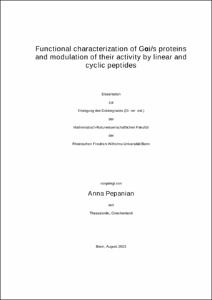Pepanian, Anna: Functional characterization of Gαi/s proteins and modulation of their activity by linear and cyclic peptides. - Bonn, 2024. - Dissertation, Rheinische Friedrich-Wilhelms-Universität Bonn.
Online-Ausgabe in bonndoc: https://nbn-resolving.org/urn:nbn:de:hbz:5-74266
Online-Ausgabe in bonndoc: https://nbn-resolving.org/urn:nbn:de:hbz:5-74266
@phdthesis{handle:20.500.11811/11280,
urn: https://nbn-resolving.org/urn:nbn:de:hbz:5-74266,
doi: https://doi.org/10.48565/bonndoc-211,
author = {{Anna Pepanian}},
title = {Functional characterization of Gαi/s proteins and modulation of their activity by linear and cyclic peptides},
school = {Rheinische Friedrich-Wilhelms-Universität Bonn},
year = 2024,
month = jan,
note = {Heterotrimeric Gαβγ (guanine nucleotide-binding) proteins serve as molecular switches to activate (“switch on”) or inactivate (“switch off”) diverse intracellular signaling cascades in response to stimulated G protein-coupled receptors (GPCRs). Modulation of these G proteins can be impelled by developing chemical tools, such as bioactive peptides. Such compounds are able to interact with distinct binding sites in the protein and inhibit protein-protein interactions. This dissertation reviews and outlines two main objectives, i) the functional characterization and activation mechanism of the Gαi1, Gαs(long), and Gαs(short) protein subunits, and ii) the development of linear and macrocyclic compounds with biological significance for the Gαi/s protein modulation. Basic computational analyses including molecular docking and dynamics simulations assisted the underlying studies.
The first aim of the present thesis is to comprehend the molecular basis for the activation of the Gαi/s protein subunits in the context of guanine nucleotide binding. The acquisition of the functional active protein substantially contributes to Gαi/s protein characterization and modulation. The determination of the active fraction of the Gαi1 and Gαs proteins and the elucidation of the biochemical differences of the Gαs(long) and (short) isoforms, which was paused for decades, pave the way for the future analysis of other Gα protein subunits. Both novel and already known non-radioactive fluorescently labeled guanine nucleotide analogs are utilized for the functional analysis and characterization of the enzymatic activity employing fluorescence, fluorescence anisotropy and GTPase-based assays.
This leads to the second main focus of this work, i.e., the development of potent and specific linear and macrocyclic peptide modulators targeting either the Gαi and/or Gαs protein subunit. Peptides derived from a one-bead-one compound (OBOC) combinatorial peptide library, such as the lead compound GPM-1 (and derivatives) exhibited a GEM (guanine exchange modulator)-like activity for the Gαi/s·GDP, i.e., the inactive protein state. A series of bicyclic compounds from a one-bead-two compound (OBTC) peptide library reveal GPM-3 as the first peptide acting as a class- and state-specific GAP (GTPase-activating protein)-like modulator of Gαi1·GMPPNP, and GPM-2 as a potential GEF (guanine nucleotide exchange factor) modulator of Gαi1·GDP.
Thus, these objectives and the results thereof are extensively described in the following chapters (the respective manuscripts are enclosed in the appendix) and could act as the stimulus for the biochemical investigation of other classes of Gα proteins either with nucleotide analogs and/or with bioactive peptides, assessing the potential druggability of G proteins in general, as well as of Gαi and Gαs in particular.},
url = {https://hdl.handle.net/20.500.11811/11280}
}
urn: https://nbn-resolving.org/urn:nbn:de:hbz:5-74266,
doi: https://doi.org/10.48565/bonndoc-211,
author = {{Anna Pepanian}},
title = {Functional characterization of Gαi/s proteins and modulation of their activity by linear and cyclic peptides},
school = {Rheinische Friedrich-Wilhelms-Universität Bonn},
year = 2024,
month = jan,
note = {Heterotrimeric Gαβγ (guanine nucleotide-binding) proteins serve as molecular switches to activate (“switch on”) or inactivate (“switch off”) diverse intracellular signaling cascades in response to stimulated G protein-coupled receptors (GPCRs). Modulation of these G proteins can be impelled by developing chemical tools, such as bioactive peptides. Such compounds are able to interact with distinct binding sites in the protein and inhibit protein-protein interactions. This dissertation reviews and outlines two main objectives, i) the functional characterization and activation mechanism of the Gαi1, Gαs(long), and Gαs(short) protein subunits, and ii) the development of linear and macrocyclic compounds with biological significance for the Gαi/s protein modulation. Basic computational analyses including molecular docking and dynamics simulations assisted the underlying studies.
The first aim of the present thesis is to comprehend the molecular basis for the activation of the Gαi/s protein subunits in the context of guanine nucleotide binding. The acquisition of the functional active protein substantially contributes to Gαi/s protein characterization and modulation. The determination of the active fraction of the Gαi1 and Gαs proteins and the elucidation of the biochemical differences of the Gαs(long) and (short) isoforms, which was paused for decades, pave the way for the future analysis of other Gα protein subunits. Both novel and already known non-radioactive fluorescently labeled guanine nucleotide analogs are utilized for the functional analysis and characterization of the enzymatic activity employing fluorescence, fluorescence anisotropy and GTPase-based assays.
This leads to the second main focus of this work, i.e., the development of potent and specific linear and macrocyclic peptide modulators targeting either the Gαi and/or Gαs protein subunit. Peptides derived from a one-bead-one compound (OBOC) combinatorial peptide library, such as the lead compound GPM-1 (and derivatives) exhibited a GEM (guanine exchange modulator)-like activity for the Gαi/s·GDP, i.e., the inactive protein state. A series of bicyclic compounds from a one-bead-two compound (OBTC) peptide library reveal GPM-3 as the first peptide acting as a class- and state-specific GAP (GTPase-activating protein)-like modulator of Gαi1·GMPPNP, and GPM-2 as a potential GEF (guanine nucleotide exchange factor) modulator of Gαi1·GDP.
Thus, these objectives and the results thereof are extensively described in the following chapters (the respective manuscripts are enclosed in the appendix) and could act as the stimulus for the biochemical investigation of other classes of Gα proteins either with nucleotide analogs and/or with bioactive peptides, assessing the potential druggability of G proteins in general, as well as of Gαi and Gαs in particular.},
url = {https://hdl.handle.net/20.500.11811/11280}
}






